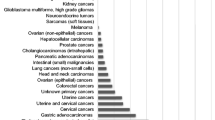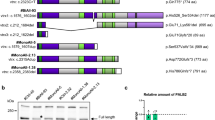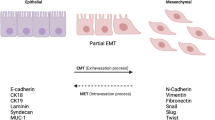Abstract
A new human uterine carcinosarcoma (UCS) cell line, TU-ECS-1, was established and characterized. The morphological appearance of the cultured cells was an insular of epithelial-like cells arranged in the form of a jigsaw puzzle and mesenchymal-like cells with a spindle-shaped or fibroblast-like morphology. A relatively high proliferation rate was observed with a doubling time of 18.2 h. The chromosome number ranged from 44 to 49 and had an extra chromosome 12 (trisomy 12). The respective half-maximal inhibitory concentrations of cisplatin, paclitaxel, and doxorubicin were 2.9 µM, 154 nM, and 219 ng/mL, respectively. Mutational analysis revealed that TU-ECS-1 cells have mutations of TP53 in exons 4, 6, and 8 and of KRAS at codon 12 (G12D) in exon 2, which is a mutation hot spot on this gene. Western blot analysis showed that p53 protein was overexpressed in TU-ECS-1 cells. Immunostaining of the cultured cells and in vivo tumors showed that the TU-ECS-1 cells and xenografts were positive for epithelial marker cytokeratin AE1/3 and mesenchymal marker vimentin. These results suggested that TU-ECS-1 cells might have both epithelial and mesenchymal characteristics. This cell line may be useful to study the carcinogenesis of UCS and contribute to the development of novel treatment strategies.






Similar content being viewed by others
References
Silverberg SG, Major FJ, Blessing JA, et al. Carcinosarcoma (malignant mixed mesodermal tumor) of the uterus. A Gynecologic Oncology Group pathologic study of 203 cases. Int J Gynecol Pathol. 1990;9:1–19.
Bansal N, Herzog TJ, Seshan VE, et al. Uterine carcinosarcomas and grade 3 endometrioid cancers: evidence for distinct tumor behavior. Obstet Gynecol. 2008;112(1):64–70.
Desai NB, Kollmeier MA, Makker V, Levine DA, Abu-Rustum NR, Alektiar KM. Comparison of outcomes in early stage uterine carcinosarcoma and uterine serous carcinoma. Gynecol Oncol. 2014;135(1):49–53.
Gonzalez Bosquet J, Terstriep SA, Cliby WA, et al. The impact of multi-modal therapy on survival for uterine carcinosarcomas. Gynecol Oncol. 2010;116(3):419–23.
Sutton G, Brunetto VL, Kilgore L, et al. A phase III trial of ifosfamide with or without cisplatin in carcinosarcoma of the uterus: a Gynecologic Oncology Group Study. Gynecol Oncol. 2000;79(2):147–53.
Yamada SD, Burger RA, Brewster WR, Anton D, Kohler MF, Monk BJ. Pathologic variables and adjuvant therapy as predictors of recurrence and survival for patients with surgically evaluated carcinosarcoma of the uterus. Cancer. 2000;88(12):2782–6.
Sutton G, Kauderer J, Carson LF, Lentz SS, Whitney CW, Gallion H. Adjuvant ifosfamide and cisplatin in patients with completely resected stage I or II carcinosarcomas (mixed mesodermal tumors) of the uterus: a Gynecologic Oncology Group study. Gynecol Oncol. 2005;96(3):630–4.
Homesley HD, Filiaci V, Markman M, et al. Phase III trial of ifosfamide with or without paclitaxel in advanced uterine carcinosarcoma: a Gynecologic Oncology Group Study. J Clin Oncol. 2007;25(5):526–31.
Gadducci A, Cosio S, Romanini A, Genazzani AR. The management of patients with uterine sarcoma: a debated clinical challenge. Crit Rev Oncol/Hematol. 2008;65(2):129–42.
Powell MA, Filiaci VL, Rose PG, et al. Phase II evaluation of paclitaxel and carboplatin in the treatment of carcinosarcoma of the uterus: a Gynecologic Oncology Group study. J Clin Oncol. 2010;28(16):2727–31.
Liu P, Cheng H, Roberts TM, Zhao JJ. Targeting the phosphoinositide 3-kinase pathway in cancer. Nat Rev Drug Discov. 2009;8(8):627–44.
Engelman JA, Luo J, Cantley LC. The evolution of phosphatidylinositol 3-kinases as regulators of growth and metabolism. Nat Rev Genet. 2006;7(8):606–19.
Brosh R, Rotter V. When mutants gain new powers: news from the mutant p53 field. Nat Rev Cancer. 2009;9(10):701–13.
Wada H, Enomoto T, Fujita M, et al. Molecular evidence that most but not all carcinosarcomas of the uterus are combination tumors. Cancer Res. 1997;57(23):5379–85.
Growdon WB, Roussel BN, Scialabba VL, et al. Tissue-specific signatures of activating PIK3CA and RAS mutations in carcinosarcomas of gynecologic origin. Gynecol Oncol. 2011;121(1):212–7.
Bashir S, Jiang G, Joshi A, et al. Molecular alterations of PIK3CA in uterine carcinosarcoma, clear cell, and serous tumors. Int J Gynecol Cancer. 2014;24(7):1262–7.
Morice P, Leary A, Creutzberg C, Abu-Rustum N, Darai E. Endometrial cancer. Lancet. 2016;387(10023):1094–108.
Vivanco I, Sawyers CL. The phosphatidylinositol 3-kinase AKT pathway in human cancer. Nat Rev Cancer. 2002;2(7):489–501.
Thigpen JT, Blessing JA, Orr JW Jr, DiSaia PJ. Phase II trial of cisplatin in the treatment of patients with advanced or recurrent mixed mesodermal sarcomas of the uterus: a Gynecologic Oncology Group Study. Cancer Treat Rep. 1986;70(2):271–4.
Curtin JP, Blessing JA, Soper JT, DeGeest K. Paclitaxel in the treatment of carcinosarcoma of the uterus: a gynecologic oncology group study. Gynecol Oncol. 2001;83(2):268–70.
Omura GA, Major FJ, Blessing JA, et al. A randomized study of adriamycin with and without dimethyl triazenoimidazole carboxamide in advanced uterine sarcomas. Cancer. 1983;52(4):626–32.
Lacour RA, Euscher E, Atkinson EN, et al. A phase II trial of paclitaxel and carboplatin in women with advanced or recurrent uterine carcinosarcoma. Int J Gynecol Cancer. 2011;21(3):517–22.
Cantrell LA, Blank SV, Duska LR. Uterine carcinosarcoma: a review of the literature. Gynecol Oncol. 2015;137(3):581–8.
Cancer Genome Atlas Research Network, Kandoth C, Schultz N, et al. Integrated genomic characterization of endometrial carcinoma. Nature. 2013;497(7447):67–73.
Kandoth C, McLellan MD, Vandin F, et al. Mutational landscape and significance across 12 major cancer types. Nature. 2013;502(7471):333–9.
Ines C, Donia O, Rahma B, et al. Implication of K-ras and p53 in colorectal cancer carcinogenesis in Tunisian population cohort. Tumour Biol. 2014;35(7):7163–75.
Mandal R, Becker S, Strebhardt K. Stamping out RAF and MEK1/2 to inhibit the ERK1/2 pathway: an emerging threat to anticancer therapy. Oncogene. 2016;35(20):2547–61.
Ihle NT, Byers LA, Kim ES, et al. Effect of KRAS oncogene substitutions on protein behavior: implications for signaling and clinical outcome. J Natl Cancer Inst. 2012;104(3):228–39.
Juliusson G, Oscier DG, Fitchett M, et al. Prognostic subgroups in B-cell chronic lymphocytic leukemia defined by specific chromosomal abnormalities. N Engl J Med. 1990;323(11):720–4.
Puiggros A, Blanco G, Espinet B. Genetic abnormalities in chronic lymphocytic leukemia: where we are and where we go. Biomed Res Int. 2014;2014:435983.
Horgas G, Grubisic G, Spaventi S. Trisomy and tetrasomy of the long arm of chromosome 1 in a direct preparation of human endometrial adenocarcinoma. Cancer Genet Cytogenet. 1988;35(2):269–72.
Gancberg D, Scourneau M, Verdebout JM, Larsimont D, Verhest A. Detection of extra chromosomes 12 by fluorescent in situ hybridization (FISH) in ovarian stromal tumors. Study of 12 cases and review of the literature. Ann Pathol. 2001;21(5):393–8.
Liang SB, Sonobe H, Taguchi T, et al. Tetrasomy 12 in ovarian tumors of thecoma-fibroma group: a fluorescence in situ hybridization analysis using paraffin sections. Pathol Int. 2001;51(1):37–42.
Fletcher JA, Gibas Z, Donovan K, et al. Ovarian granulosa-stromal cell tumors are characterized by trisomy 12. Am J Pathol. 1991;138(3):515–20.
Falisi E, Novella E, Visco C, et al. B-cell receptor configuration and mutational analysis of patients with chronic lymphocytic leukaemia and trisomy 12 reveal recurrent molecular abnormalities. Hematol Oncol. 2014;32(1):22–30.
Acknowledgements
We thank Mr. Noriyuki Yamada of the Department of Pathology at Iwate Medical University School of Medicine for assisting with immunohistochemical analysis. The present study was supported by the Project of Human Resource Development for Cancer from the Ministry of Education, Culture, Sports, Science and Technology of Japan and Leading Center for the Development and Research of Cancer Medicine from the Ministry of Education, Culture, Sports, Science and Technology of Japan.
Author information
Authors and Affiliations
Corresponding author
Ethics declarations
Conflict of interest
The authors declare that they have no conflicts of interest.
Rights and permissions
About this article
Cite this article
Chiba, Y., Sato, S., Itamochi, H. et al. Establishment and characterization of a novel uterine carcinosarcoma cell line, TU-ECS-1, with mutations of TP53 and KRAS . Human Cell 30, 140–148 (2017). https://doi.org/10.1007/s13577-016-0154-6
Received:
Accepted:
Published:
Issue Date:
DOI: https://doi.org/10.1007/s13577-016-0154-6




